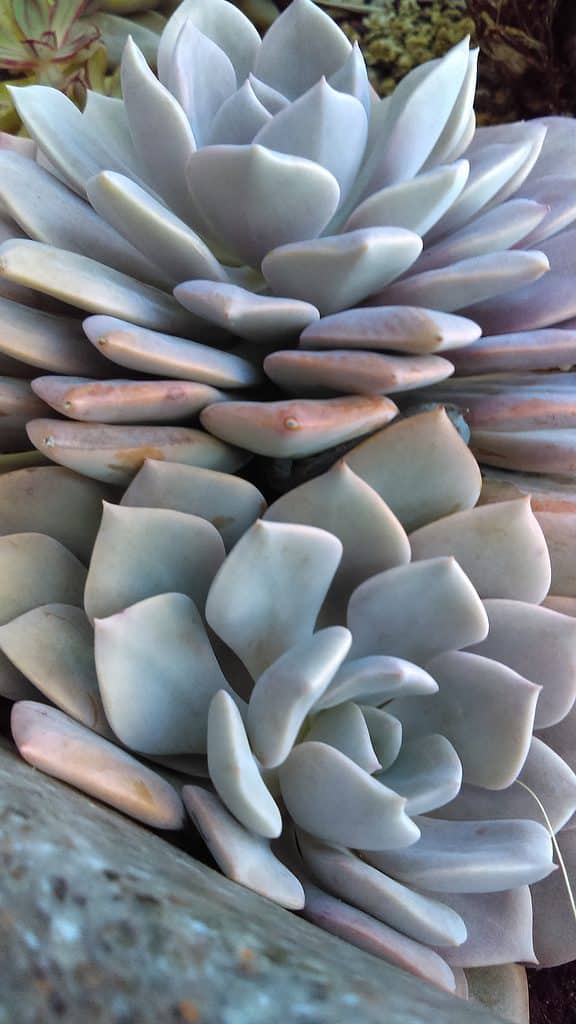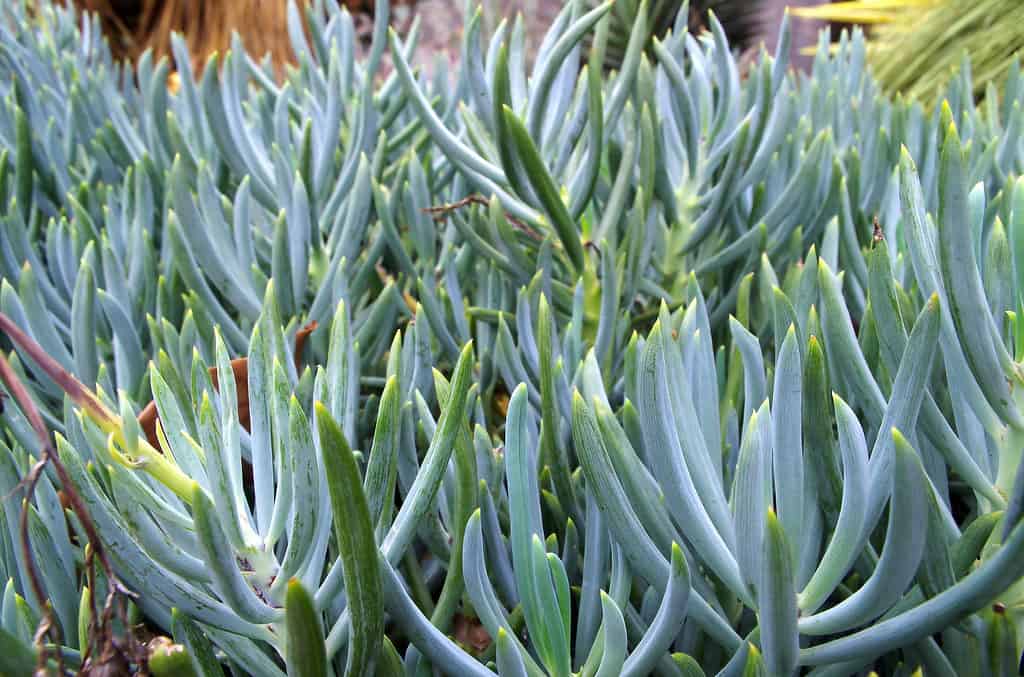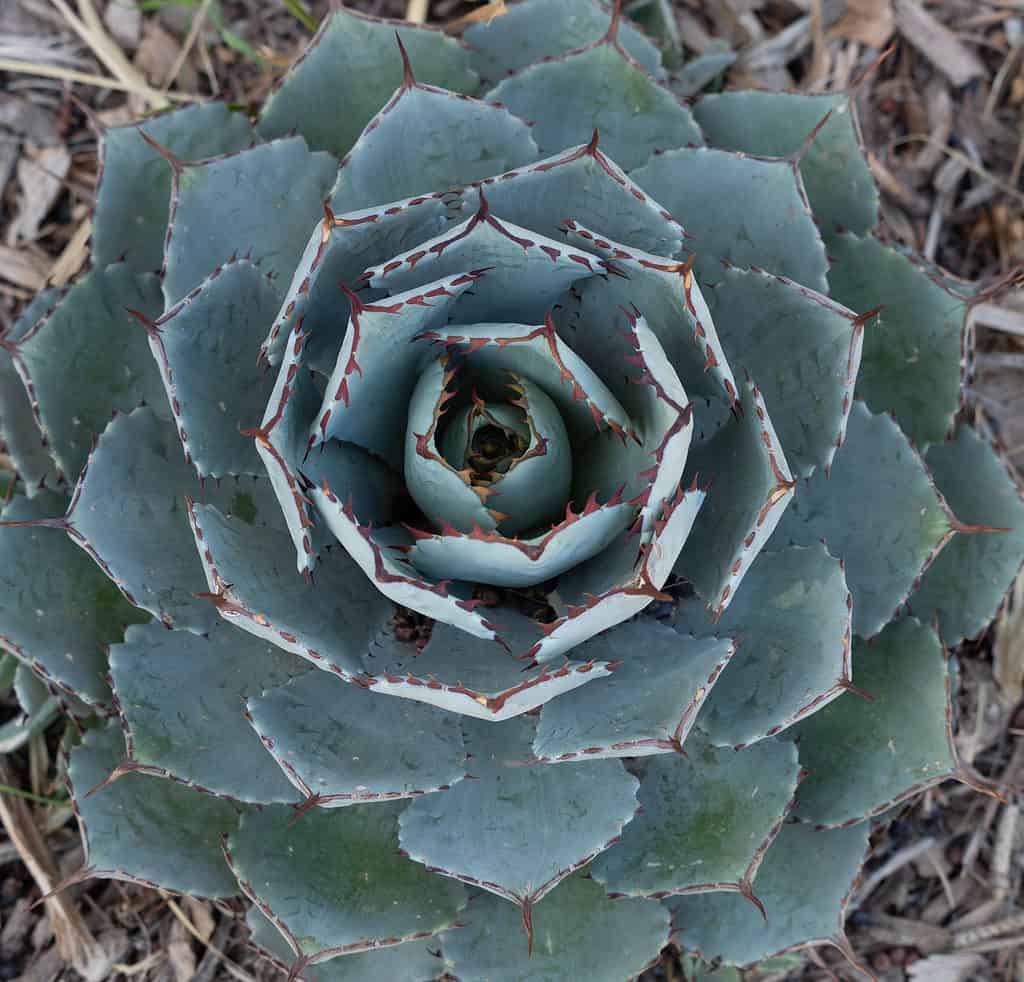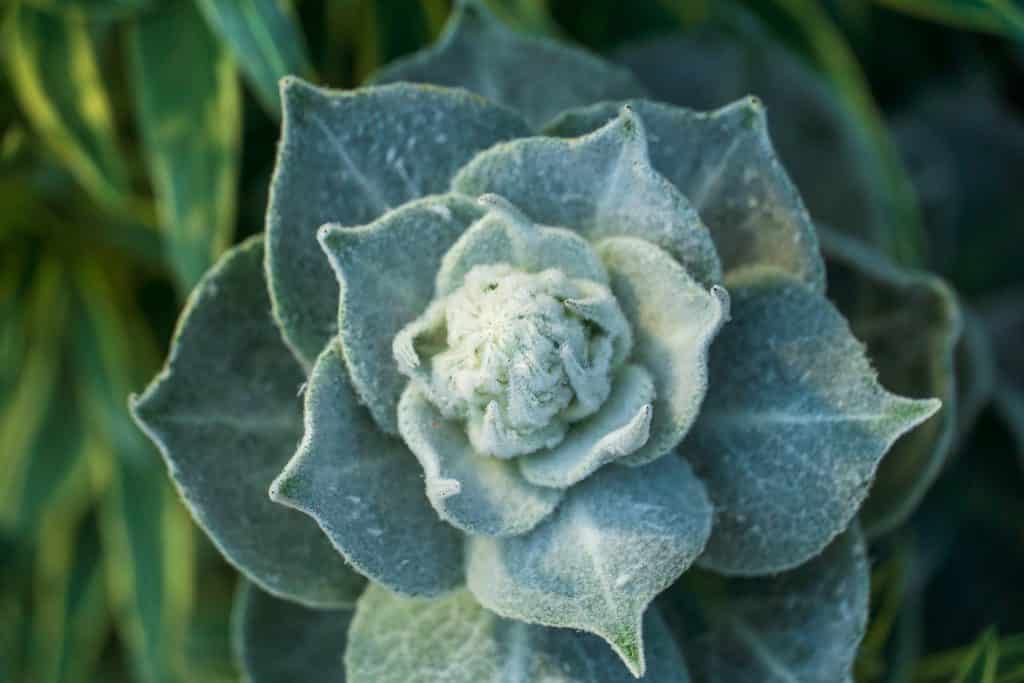Many succulents seem to almost thrive on neglect. Because they require such minimal care, it’s easy for a beginning (or forgetful) gardener to create a succulent plant display that will rival that of any expert grower.
Adding a variety of colors is an easy way to take your succulent display to the next level. Of course, there are countless green succulent varieties, but there are also varieties that feature hues of pink, red, yellow, purple, silver, white, and blue. Let’s talk a bit about blue succulents.

Most blue succulents will remain green unless they get a lot of sunlight. This is because they contain a pigment called anthocyanin that protects them from sun damage. When grown indoors without ample sun, less pigment will be produced, and the blue colors will remain hidden. But the full depth of blue shades will surface when the plants are “happily stressed” by the sun.
It’s also worth noting that most blue succulents display a pale or pastel blue. The pictures of bright, vivid, almost neon-blue plants you may have seen on commercial gardening sites are usually Photoshopped or otherwise enhanced. Too many growers feel like failures when their plants don’t live up to the pictures they’ve seen on the internet. It’s important to remember that even the plants in those pictures don’t look like that in reality.
Now that you’re armed with some basic information, here are five blue succulents (along with realistic pictures) that you can add to your collection.
1. Blue Agave (Agave azul)
This is probably the most famous of all blue succulents, mostly because it is the main ingredient in tequila. You will even see a different botanical name, Agave tequilana, used for this plant. It’s also sometimes referred to as the “tequila cactus,” even though it’s not a true cactus.
But beyond its use in making distilled liquor, blue agave is also a wonderful ornamental plant. For outdoor gardens, the blue agave has a limited range. Native to Mexico and the Caribbean, blue agave is only recommended for growing in Zones 9b-10 on the USDA plant hardiness scale. However, you can grow it as a houseplant in colder zones.
Blue agaves need around six hours of sun each day. If you don’t have an indoor space that receives ample sunlight, you can use grow lights as a supplement. Moving them outside on warm sunny days is a great idea. Just remember to bring them in at night. Blue agaves are not cold-hardy, so temperatures lower than 50°F can damage them.
This isn’t a petite plant for your windowsill. The blue agave can grow up to eight feet tall and equally wide. But it grows relatively slowly, so it won’t outgrow your living room overnight.
Agave plants are mildly toxic for pets.

The blue agave plants in this Mexican field are raised for tequila production.
©javarman/Shutterstock.com
2. Prolific Echeveria (Echeveria prolifica)
This plant certainly lives up to its name. It is prolific in forming offsets. These offsets cluster together, forming a dense mat.
It’s also prolific in its coloration. If you want to add color to your display, this single plant will provide multiple hues, including green, pink, and turquoise blue, when it receives adequate sunlight (six hours daily). The colorful leaves grow in a rosette, measuring 3-4 inches at maturity.
The prolific echeveria is a hybrid plant native to Mexico and is recommended for outdoor gardens in Zones 9a-11b. It is one of the fastest-growing echeveria varieties on the market, and, with the proliferation of offsets, it will provide lovely ground cover relatively quickly.
It also thrives as a houseplant. You can confine it to a more limited space with proper pruning. You may also choose to remove the offsets and propagate plants for friends and family members.
Echeveria plants are non-toxic for pets.

The prolific echeveria is multi-colored, including shades of green, pink, and blue.
©Erika Kirkpatrick/Shutterstock.com
3. Blue chalksticks (Senecio mandraliscae)
The blue chalk sticks plant (sometimes referred to as “bluefingers” or “bluesticks”) is native to South Africa. This dwarf shrub grows 12-18 inches tall and can spread up to two feet wide. It features stick-like fleshy leaves with a lovely greenish-blue color that quickly forms a dense mat. When grown as a groundcover, it can give an almost aquatic, under-the-sea look to a garden.
The blue chalk sticks plant is recommended for Zones 9a-11b. It will not tolerate temperatures below 40°F. In cooler zones, you can move the plants outside during the summer, where they can soak up the sun, but be sure to bring them inside before the temperature drops.
When growing indoors, a bright sunny window is best, although it can tolerate a bit more filtered light than many other succulents.
All senecio are toxic to pets.

The blue chalksticks succulent features greenish-blue finger-like leaves.
©nega/Shutterstock.com
4. Butterfly Agave (Agave potatorum)
This is another agave succulent with an alcoholic connection. The plant was used by the Nahuatl-speaking tribes in its native Mexico to create an alcoholic beverage. It is sometimes still referred to as the “drunkard agave.” The botanical name, A. potatorum, comes from the Latin word potator, meaning “drunk” or “one who drinks.”
The more common name today, butterfly agave, refers to the leaves of this succulent, which resemble the wings of a butterfly.
This plant grows in a compact, symmetrical rosette pattern and can reach two feet high and three feet wide. The leaves are silvery-blue, edged with red spines. Each leaf is tipped with a sharp brown spine.
The plant is hardy from Zones 9b-11, where it can adorn rock gardens and other sun-drenched, well-draining spaces.
When grown indoors, give it as much sun as possible, but it doesn’t necessarily require full sun.
As noted earlier, agaves are toxic for pets. They contain a sap that is a skin irritant, and the large brown spikes are quite sharp. Use caution if you have young children or pets.

The butterfly agave grows in a nearly perfect symmetrical rosette.
©Dee Carpenter Originals/Shutterstock.com
5. Blue Spruce Sedum (Sedum reflexum ‘Blue Spruce’)
This sedum features blue-green leaves that closely resemble the needles of a blue spruce conifer. It spreads easily, creating a garden ground cover that looks like a tiny blue spruce forest.
The blue spruce sedum is much more cold-tolerant than many other succulents. It is winter-hardy for Zones 4-9 and is tolerant of temperatures down to -30°F. If grown in gravelly, well-draining soil, this succulent can really stand up to Old Man Winter. And along with being frost tolerant, this plant is also drought tolerant. It truly is one of the lowest-maintenance succulents you’ll find anywhere.
Small star-shaped yellow flowers bloom during the summer and are a favorite of pollinators. But, while butterflies love these plants, deer and rabbits do not. Blue spruce succulents will be a great addition if these animals treat your garden as their own personal salad bar.
All 600+ sedum species are non-toxic.

The blue spruce sedum blooms with small yellow flowers in the summer.
©iStock.com/surotbar
Final Thoughts
No matter where you live or your level of gardening experience, there is a succulent that can fit perfectly in your setting. And there is a wonderful color palette to choose from, as well. One of these blue succulents may just be the perfect next plant for your home or garden.

Blue succulents, such as the echeveria prolifica, are an easy way to add color to your garden or home display.
©Wirestock Creators/Shutterstock.com
Summary of 5 Types of Blue Succulents
| # | Succulent | Toxicity |
|---|---|---|
| 1 | Blue Agave | Mildly toxic to pets |
| 2 | Prolific Echeveria | Non-toxic |
| 3 | Blue Chalksticks | Toxic to pets |
| 4 | Butterfly Agave | Toxic to pets |
| 5 | Blue Spruce Sedum | Non-toxic |
The photo featured at the top of this post is © Krittrin Khemdang/Shutterstock.com
Thank you for reading! Have some feedback for us? Contact the AZ Animals editorial team.






